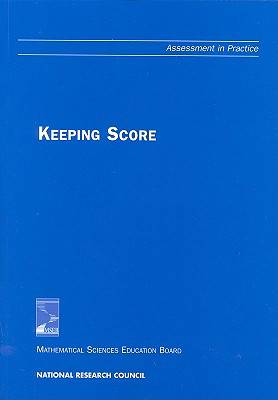
- Afhalen na 1 uur in een winkel met voorraad
- Gratis thuislevering in België vanaf € 30
- Ruim aanbod met 7 miljoen producten
- Afhalen na 1 uur in een winkel met voorraad
- Gratis thuislevering in België vanaf € 30
- Ruim aanbod met 7 miljoen producten
Keeping Score
National Research Council, Center for Science Mathematics and Engineering Education, Mathematical Sciences Education Board, Ann ShannonOmschrijving
Curriculum reform, performance assessment, standards, portfolios, and high stakes testing-what's next? What does this all mean for me in my classroom? Many teachers have asked such questions since mathematics led the way in setting standards with the publication of the Curriculum and Evaluation Standards for School Mathematics (National Council of Teachers of Mathematics [NCTM], 1989). This seminal document and others that followed served as catalysts for mathematics education reform, giving rise to new initiatives related to curriculum, instruction, and assessment over the past decade. In particular, approaches to classroom, school, and district-wide assessment have undergone a variety of changes as educators have sought to link classroom teaching to appropriate assessment opportunities.
Since the publication of Everybody Counts (National Research Council [NRC], 1989), the Mathematical Sciences Education Board (MSEB) has dedicated its efforts to the improvement of mathematics education. A national summit on assessment led to the publication of For Good Measure (NRC, 1991). This statement of goals and objectives for assessment in mathematics was followed by Measuring Up (NRC, 1993a), which provided prototypical fourth-grade performance assessment tasks linked to the goals of the NCTM's Curriculum and Evaluation Standards. Measuring What Counts (NRC, 1993b) demonstrated the importance of mathematics content, learning, and equity as they relate to assessment. The MSEB is now prepared to present perspectives on issues in mathematics education assessment for those most directly engaged in implementing the reform initiatives on a daily basis-classroom teachers, school principals, supervisors, and others in school-based settings.
Specificaties
Betrokkenen
- Auteur(s):
- Uitgeverij:
Inhoud
- Aantal bladzijden:
- 96
- Taal:
- Engels
- Reeks:
Eigenschappen
- Productcode (EAN):
- 9780309065351
- Verschijningsdatum:
- 16/12/1999
- Uitvoering:
- Paperback
- Formaat:
- Trade paperback (VS)
- Afmetingen:
- 181 mm x 255 mm
- Gewicht:
- 217 g

Alleen bij Standaard Boekhandel
Beoordelingen
We publiceren alleen reviews die voldoen aan de voorwaarden voor reviews. Bekijk onze voorwaarden voor reviews.











